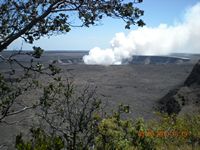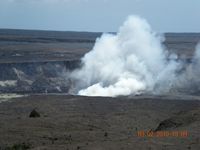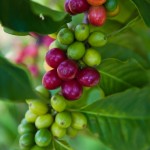Pele, the Hawaiian Goddess of Fire
who makes her home in Kilauea at the Hawaii Volcanoes National Park. There are many stories of her origins, many of which are similar to stories of Maori’an legends in New Zealand.
In addition to the legends of how Pele came to make her home on the Big Island, there are also stories told of how she appears to people from time to time as either an old woman or a beautiful young lady. She can be found hitchhiking along the roads or knocking on doors asking for something to eat.
One story, who’s origins have been long forgotten, say that a young couple was driving along one night and picked up an old woman who was hitchhiking and the old lady got in the back with their infant daughter. They talked for a while and then there was a prolonged silence.
When the wife turned to ask a question of the old lady, the infant was sitting alone in the back seat. They had not stopped, had not heard the door open, she had simply disappeared. At other times, stories are told of picking up a beautiful, young woman who similarly disappears from the car.
Pele’s First Car Ride
The earliest recorded case of Pele hitching a ride in an automobile was in 1925. As the story goes, a young Japanese man was driving his new Ford on the road to Kona in the Kau/South Kona area. There was an old lady walking along the road, and first one, then another car passed her by without pausing, and this young man in the 3rd car, stopped and asked where she was going.
When she indicated that she was going to a place not far from where he himself was headed, he offered her a ride. Along the way, they soon past the first two cars, both of which were broken down alongside the road and she smiled as they passed each one.
As they got close. to his destination, he told her that they were almost where he was going, but that if she needed to go further, he would take her. When he did not receive an answer, he turned and found that she had vanished!
House Saved From Lava Flow
In another story, an old lady was knocking on doors asking for something to eat and everyone had turned her away. Finally, she got to one house and the woman gave her some food to eat and drink. As the old lady was leaving, she turned to the gracious homeowner and said, “The volcano will erupt soon and when it does, tie a red piece of cloth to each corner of your property and your home will be protected.”
As you have already guessed, the volcano did indeed erupt and the lady did as she had been instructed. When the lava flow reached the property, it went around their house and the house was spared, while all those who had turned away the old woman days earlier, were destroyed.
One of the most renown believers in Pele was Uncle George Lycurgus, the owner of the famous Volcano House hotel, located on the edge of Halemaumau Crater. One story is that he and his friends had joined a group of Hawaiians one night in the 1920’s, for a luau at the edge of Halemaumau.
The Volcano House
At the edge of their luau, some 75′ away, he saw an old woman with long, scraggly white hair, standing with a shawl wrapped around her shoulders. She walked towards the edge of the pit and when one of the group asked if she wanted to join them, she declined, saying that she had work to do.
And, simply turned and walked toward the pit…and disappeared. Thinking she had fallen in, they all rushed to see what happened to her, but she was nowhere to be seen. The Hawaiians all figured that she had to be Pele. And, almost immediately, the volcano started to erupt!
Sometime in the early 1930’s, the Volcano House caught fire and threatened to burn completely down as the wind pushed the fire through the hotel. Uncle George is said to have cried out in desperation, “God…can nothing be done to save this place from complete destruction?” and with that, the winds changed direction and stopped the fire from spreading further. Pele? Something else?
Well, Uncle George was convinced it was Madam Pele stepping in to help save his hotel. In 1932, when business was doing badly, he placed a bottle of gin and a lei of ohelo berries in the crater as an offering to Pele and that night, the crater began erupting, spurring business for his hotel once again.
The Volcano House is undergoing an almost complete refurbishing and should be open for business once again later this year. It has been closed for sometime now as the work progressed. Its located across the road from the Visitor’s Center, so make sure you stop by to visit this historical hotel.
Fortunately, you won’t have to sacrifice any gin to Pele, as she has been quite active and is not showing any signs of letting up any time soon. It’s definitely a “must see” on anyone’s visit to the Big island of Hawaii!









